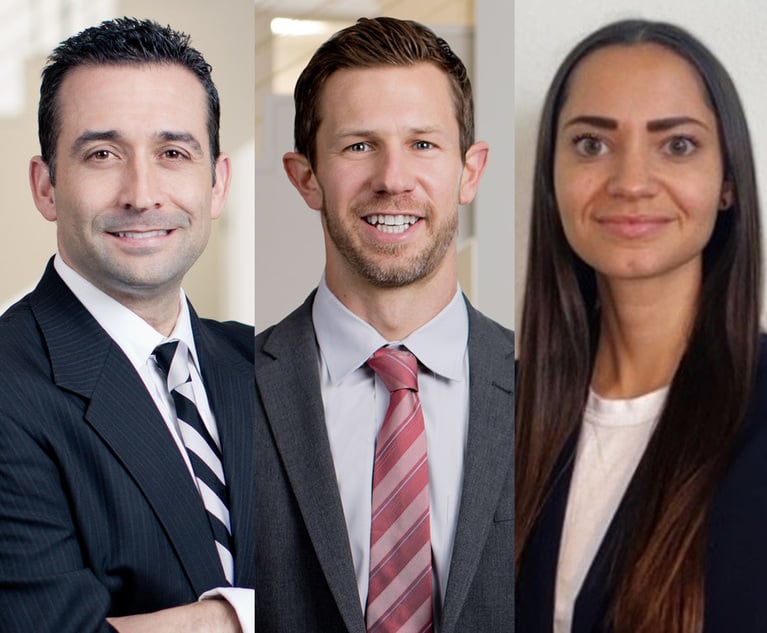Q&A: ACLU's Wessler on the SCOTUS Cell-Site Data Case
In a new podcast, Law.com talks with the lead attorney arguing against the government in Carpenter v. U.S., a case set to be argued before the U.S. Supreme Court this week that tests the limits of privacy when it comes to cellular location data.
November 28, 2017 at 10:50 AM
13 minute read

The U.S. Supreme Court on Wednesday will hear arguments on the limits of privacy in an age where we all carry around devices capable of tracking our location.
In Carpenter v. U.S., the central question before the court is whether authorities should have had to get a warrant for several months' worth of a suspect's cell-site location information or if his privacy interests under the Fourth Amendment were given up under the “third-party doctrine.”
Arguing against the government is ACLU staff attorney Nathan Wessler. In an interview on Law.com's “Unprecedented” podcast, Wessler explained why he doesn't think the third-party doctrine applies to today's technology. Below is an excerpt from the conversation.
Listen to the full podcast online here or on your iOS or Android device. This excerpt has been edited for clarity and length.
Want more coverage from the intersection of technology and the law? Click here to sign up for Ben Hancock's weekly briefing, What's Next—a look at the courtroom clashes and policy choices that loom over emerging technologies.
“Unprecedented” host Ben Hancock: You equate the data that authorities can get through cell sites as almost like a GPS. The government says it's more approximate—somewhere between a half-mile and 2 miles. Talk to me about the technology of the cell site.
Nathan Wessler: The records from Mr. Carpenter's case are from 2010 and 2011, and the government's right that in those records most of the individual location points are less precise than GPS coordinates. But they still are highly revealing and still, we think, really infringe on people's expectation of privacy. … When we took a look at the records ourselves, we were able to tell things like when he slept at home and when he slept at a neighborhood four miles away in Detroit. We were able to look at his pattern of movements every Sunday afternoon, when in fact he was going to church. So quite sensitive.
But in the intervening seven years that it's taken for this case to make its way up to the Supreme Court, the technology has really changed in significant ways so that location points are more and more precise every year. As more people are using smartphones and using more data on them, carriers have had to erect more cell towers to handle that large amount of data bandwidth. And that means towers get closer together, so their coverage area shrinks, which means you can more precisely locate someone.
Carriers are also deploying hundreds of thousands of what are called “small cells,” which are kind of like little mini cell towers that cover smaller areas. If a customer of a service provider has poor reception in their house, they might be able to install one of these right in their home.
Hancock: Professor Orin Kerr of George Washington University has had a lot to say about the third-party doctrine, and he argues that using the cell network is the modern-day equivalent of walking out into public space to deliver a message. I take it you disagree with that, but tell me why that's wrong.
Wessler: I think the important point isn't that I disagree with that—which I do—but it's that five members of the Supreme Court have already said that they disagree with that. That's the five justices who concurred in the Jones opinion. The government's argument in Jones, about GPS tracking, was to rely on a case from the 1980s, United States v. Knotts, where police used a rudimentary beeper tracking device that they had surreptitiously put in a canister … and the court in the 1980s said, “Look, this is just a half-step beyond normal visual surveillance where you're tailing a suspect for a short period of time. No warrant is required.”
But in Jones, now in the digital age talking about a very powerful GPS device that can track someone without any involvement of police for weeks on end and just send the information to a police computer somewhere, the court said that old rule just doesn't apply anymore. There's something qualitatively different between the kind of effortful action of having to follow a car with a radio receiver, and if you lose the car they had to send in a helicopter to find it again. That's just not the same as this kind of cheap, easy, and invasive electronic tracking.
Sure, if I walk outside, I fully expect that there may be some number of people who happen to see me when I go to the mailbox, or [when] I go to a store or a restaurant, or I get in my car. But what we've never expected—and this is what the five justices explained in Jones—is that there would be someone following us, hour after hour for days and weeks and months, without blinking, without taking a bathroom break, without taking a nap. That kind of pervasive surveillance just violates our expectations of privacy and is regulated by the Fourth Amendment.
Hancock: This order for the cellphone location records was issued under the Stored Communications Act, I think Section 2703. Do you see that there's an inherent conflict between this provision of the SCA and the Fourth Amendment, such that the provision itself is unconstitutional, or is it purely a matter of interpreting the SCA in the right way?
Wessler: The short answer is that Congress actually has a kind of safety valve provision in the Stored Communications Act that provides a way to get a warrant for these kinds of records. The background is that Congress passed the [SCA] in 1986. A fraction of 1 percent of all Americans had cellphones in 1986; there were about 1,000 cell towers in the whole country compared to more than 300,000 today. … They amended the statute in 1994 to include the current language to allow for that court order provision; about 9 percent of Americans had cellphones in 1994, there were about 18,000 cell towers. So, again, just a fraction of the coverage here. And there's no indication in the legislative history at all that Congress was thinking about the existence of these location records or the fact that the government might want to get someone's historical location from their cellphone service provider.
And so Congress wasn't thinking about this in particular. But Congress did create two options—two mechanisms—for police to go to a company to get telecommunications service records. Either an order under section 2703(d), the kind of order they got here, or a search warrant. And the only logical reason they did that is that Congress realized there might be some kinds of records they hadn't thought about yet that would be very private and that might be regulated under the Fourth Amendment, and so they should create a mechanism for getting those without violating the Constitution.

The U.S. Supreme Court on Wednesday will hear arguments on the limits of privacy in an age where we all carry around devices capable of tracking our location.
In Carpenter v. U.S., the central question before the court is whether authorities should have had to get a warrant for several months' worth of a suspect's cell-site location information or if his privacy interests under the Fourth Amendment were given up under the “third-party doctrine.”
Arguing against the government is ACLU staff attorney Nathan Wessler. In an interview on Law.com's “Unprecedented” podcast, Wessler explained why he doesn't think the third-party doctrine applies to today's technology. Below is an excerpt from the conversation.
Listen to the full podcast online here or on your iOS or Android device. This excerpt has been edited for clarity and length.
Want more coverage from the intersection of technology and the law? Click here to sign up for Ben Hancock's weekly briefing, What's Next—a look at the courtroom clashes and policy choices that loom over emerging technologies.
“Unprecedented” host Ben Hancock: You equate the data that authorities can get through cell sites as almost like a GPS. The government says it's more approximate—somewhere between a half-mile and 2 miles. Talk to me about the technology of the cell site.
Nathan Wessler: The records from Mr. Carpenter's case are from 2010 and 2011, and the government's right that in those records most of the individual location points are less precise than GPS coordinates. But they still are highly revealing and still, we think, really infringe on people's expectation of privacy. … When we took a look at the records ourselves, we were able to tell things like when he slept at home and when he slept at a neighborhood four miles away in Detroit. We were able to look at his pattern of movements every Sunday afternoon, when in fact he was going to church. So quite sensitive.
But in the intervening seven years that it's taken for this case to make its way up to the Supreme Court, the technology has really changed in significant ways so that location points are more and more precise every year. As more people are using smartphones and using more data on them, carriers have had to erect more cell towers to handle that large amount of data bandwidth. And that means towers get closer together, so their coverage area shrinks, which means you can more precisely locate someone.
Carriers are also deploying hundreds of thousands of what are called “small cells,” which are kind of like little mini cell towers that cover smaller areas. If a customer of a service provider has poor reception in their house, they might be able to install one of these right in their home.
Hancock: Professor Orin Kerr of
Wessler: I think the important point isn't that I disagree with that—which I do—but it's that five members of the Supreme Court have already said that they disagree with that. That's the five justices who concurred in the Jones opinion. The government's argument in Jones, about GPS tracking, was to rely on a case from the 1980s, United States v. Knotts, where police used a rudimentary beeper tracking device that they had surreptitiously put in a canister … and the court in the 1980s said, “Look, this is just a half-step beyond normal visual surveillance where you're tailing a suspect for a short period of time. No warrant is required.”
But in Jones, now in the digital age talking about a very powerful GPS device that can track someone without any involvement of police for weeks on end and just send the information to a police computer somewhere, the court said that old rule just doesn't apply anymore. There's something qualitatively different between the kind of effortful action of having to follow a car with a radio receiver, and if you lose the car they had to send in a helicopter to find it again. That's just not the same as this kind of cheap, easy, and invasive electronic tracking.
Sure, if I walk outside, I fully expect that there may be some number of people who happen to see me when I go to the mailbox, or [when] I go to a store or a restaurant, or I get in my car. But what we've never expected—and this is what the five justices explained in Jones—is that there would be someone following us, hour after hour for days and weeks and months, without blinking, without taking a bathroom break, without taking a nap. That kind of pervasive surveillance just violates our expectations of privacy and is regulated by the Fourth Amendment.
Hancock: This order for the cellphone location records was issued under the Stored Communications Act, I think Section 2703. Do you see that there's an inherent conflict between this provision of the SCA and the Fourth Amendment, such that the provision itself is unconstitutional, or is it purely a matter of interpreting the SCA in the right way?
Wessler: The short answer is that Congress actually has a kind of safety valve provision in the Stored Communications Act that provides a way to get a warrant for these kinds of records. The background is that Congress passed the [SCA] in 1986. A fraction of 1 percent of all Americans had cellphones in 1986; there were about 1,000 cell towers in the whole country compared to more than 300,000 today. … They amended the statute in 1994 to include the current language to allow for that court order provision; about 9 percent of Americans had cellphones in 1994, there were about 18,000 cell towers. So, again, just a fraction of the coverage here. And there's no indication in the legislative history at all that Congress was thinking about the existence of these location records or the fact that the government might want to get someone's historical location from their cellphone service provider.
And so Congress wasn't thinking about this in particular. But Congress did create two options—two mechanisms—for police to go to a company to get telecommunications service records. Either an order under section 2703(d), the kind of order they got here, or a search warrant. And the only logical reason they did that is that Congress realized there might be some kinds of records they hadn't thought about yet that would be very private and that might be regulated under the Fourth Amendment, and so they should create a mechanism for getting those without violating the Constitution.
NOT FOR REPRINT
© 2025 ALM Global, LLC, All Rights Reserved. Request academic re-use from www.copyright.com. All other uses, submit a request to [email protected]. For more information visit Asset & Logo Licensing.
You Might Like
View All
US Patent Innovators Can Look to International Trade Commission Enforcement for Protection, IP Lawyers Say

How the Deal Got Done: Sidley Austin and NWSL Angel City Football Club/Iger

How Uncertainty in College Athletics Compensation Could Drive Lawsuits in 2025

How I Made Practice Group Chair: 'Think About Why You Want the Role, Because It Is Not an Easy Job,' Says Aaron Rubin of Morrison Foerster
Trending Stories
- 1Deal Watch: Latham, Paul Weiss, Debevoise Land on Year-End Big Deals. Plus, Mixed Messages for 2025 M&A
- 2Bathroom Recording Leads to Lawyer's Disbarment: Disciplinary Roundup
- 3Conn. Supreme Court: Workers' Comp Insurance Cancellations Must Be Unambiguous
- 4To Avoid Conflict, NYAG Hands Probe Into Inmate's Beating Death to Syracuse-Area DA
- 5Scripture-Quoting Employee Sues Company for Supporting LGBTQ Pride
Who Got The Work
Michael G. Bongiorno, Andrew Scott Dulberg and Elizabeth E. Driscoll from Wilmer Cutler Pickering Hale and Dorr have stepped in to represent Symbotic Inc., an A.I.-enabled technology platform that focuses on increasing supply chain efficiency, and other defendants in a pending shareholder derivative lawsuit. The case, filed Oct. 2 in Massachusetts District Court by the Brown Law Firm on behalf of Stephen Austen, accuses certain officers and directors of misleading investors in regard to Symbotic's potential for margin growth by failing to disclose that the company was not equipped to timely deploy its systems or manage expenses through project delays. The case, assigned to U.S. District Judge Nathaniel M. Gorton, is 1:24-cv-12522, Austen v. Cohen et al.
Who Got The Work
Edmund Polubinski and Marie Killmond of Davis Polk & Wardwell have entered appearances for data platform software development company MongoDB and other defendants in a pending shareholder derivative lawsuit. The action, filed Oct. 7 in New York Southern District Court by the Brown Law Firm, accuses the company's directors and/or officers of falsely expressing confidence in the company’s restructuring of its sales incentive plan and downplaying the severity of decreases in its upfront commitments. The case is 1:24-cv-07594, Roy v. Ittycheria et al.
Who Got The Work
Amy O. Bruchs and Kurt F. Ellison of Michael Best & Friedrich have entered appearances for Epic Systems Corp. in a pending employment discrimination lawsuit. The suit was filed Sept. 7 in Wisconsin Western District Court by Levine Eisberner LLC and Siri & Glimstad on behalf of a project manager who claims that he was wrongfully terminated after applying for a religious exemption to the defendant's COVID-19 vaccine mandate. The case, assigned to U.S. Magistrate Judge Anita Marie Boor, is 3:24-cv-00630, Secker, Nathan v. Epic Systems Corporation.
Who Got The Work
David X. Sullivan, Thomas J. Finn and Gregory A. Hall from McCarter & English have entered appearances for Sunrun Installation Services in a pending civil rights lawsuit. The complaint was filed Sept. 4 in Connecticut District Court by attorney Robert M. Berke on behalf of former employee George Edward Steins, who was arrested and charged with employing an unregistered home improvement salesperson. The complaint alleges that had Sunrun informed the Connecticut Department of Consumer Protection that the plaintiff's employment had ended in 2017 and that he no longer held Sunrun's home improvement contractor license, he would not have been hit with charges, which were dismissed in May 2024. The case, assigned to U.S. District Judge Jeffrey A. Meyer, is 3:24-cv-01423, Steins v. Sunrun, Inc. et al.
Who Got The Work
Greenberg Traurig shareholder Joshua L. Raskin has entered an appearance for boohoo.com UK Ltd. in a pending patent infringement lawsuit. The suit, filed Sept. 3 in Texas Eastern District Court by Rozier Hardt McDonough on behalf of Alto Dynamics, asserts five patents related to an online shopping platform. The case, assigned to U.S. District Judge Rodney Gilstrap, is 2:24-cv-00719, Alto Dynamics, LLC v. boohoo.com UK Limited.
Featured Firms
Law Offices of Gary Martin Hays & Associates, P.C.
(470) 294-1674
Law Offices of Mark E. Salomone
(857) 444-6468
Smith & Hassler
(713) 739-1250






